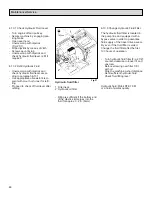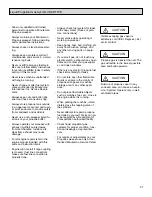
Before operating the engine, read the
Operator’s Manual and become famil-
iar with it and the equipment. Safe
and efficient operation can be
achieved only if the equipment is
properly operated and maintained.
The following symbols, found
throughout this manual, alert you to
potentially dangerous conditions to
the operator, service personnel, or
the equipment.
This symbol warns of immediate haz-
ards that will result in severe personal
injury or death.
This symbol refers to a hazard or
unsafe practice that can result in
severe personal injury or death.
This symbol refers to a hazard or
unsafe practice that can result in per-
sonal injury or product or property
damage.
Fuels, electrical equipment, batteries,
exhaust gases and moving parts
present potential hazards that can
result in severe personal injury. Take
care in following these recommended
procedures. All local, state and feder-
al codes should be consulted and
complied with.
GENERAL
- Provide appropriate fire extinguish-
ers and install in convenient loca-
tions. Use an extinguisher rated
ABC by NFPA.
- Make sure that all fasteners on the
engine are secure and accurately
torqued. Keep guards in position
over fans, driving belts, etc.
- If it is necessary to make adjust-
ments while the engine is running,
use extreme caution when close to
hot exhausts, moving parts, etc.
- Used engine oils have been identi-
fied by some state or federal agen-
cies as causing cancer or reproduc-
tive toxicity. When checking or
changing engine oil, take care not
to ingest, breathe the fumes, or
contact used oil.
- Do not work on this equipment
when mentally or physically fa-
tigued, or after consuming any alco-
hol or drug that makes the opera-
tion of equipment unsafe.
BATTERIES
- Before starting work on the engine,
disconnect batteries to prevent in-
advertent starting of the engine.
- DO NOT SMOKE while servicing
batteries. Lead acid batteries give
off a highly explosive hydrogen gas
which can be ignited by flame, elec-
trical arcing or by smoking.
- Verify battery polarity before con-
necting battery cables. Connect
negative cable last.
FUEL SYSTEM
- DO NOT fill fuel tanks while engine
is running.
- DO NOT smoke or use an open
flame in the vicinity of the engine or
fuel tank. Internal combustion en-
gine fuels are highly flammable.
- Fuel line must be LP approved, ad-
equately secured, and free from
leaks. Piping at the engine should
be approved flexible line. Do not
use copper piping for flexible lines
as copper will work harder and be-
come brittle enough to break.
- Be sure all fuel supplies have a
positive shut-off valve.
PROTECT AGAINST MOVING
PARTS
- Do not wear loose clothing in the
vicinity of moving parts, such as
PTO shafts, flywheels, blowers,
couplings, fans belts, etc.
- Keep your hands away from mov-
ing parts.
EXHAUST SYSTEM
- Exhaust products of any internal
combustion engine are toxic and
can cause injury, or death if in-
haled. When operating the engine
in a confined area, make sure the
ventilation system is operating
properly.
- DO NOT use exhaust gases to heat
a compartment.
- Make sure that your exhaust sys-
tem is free of leaks. Make sure that
exhaust manifolds are secure and
are not warped by bolts unevenly
torqued.
EXHAUST GAS IS DEADLY!
- Exhaust gases contain carbon
monoxide, a poisonous gas that
can cause unconsciousness and
death. It is an odorless and color-
less gas formed during combustion
of hydrocarbon fuels. Symptoms of
carbon monoxide poisoning are:
Dizziness, Headache, Weakness
and Sleepiness, Throbbing in Tem-
ples, Vomiting, Muscular Twitching
If you experience any of these symp-
toms, get out into fresh air immedi-
ately, shut down the unit and do not
use it until it has been inspected.
The best protection against carbon
monoxide inhalation is proper instal-
lation and regular, frequent inspec-
tions of the complete exhaust sys-
tem. If you notice a change in the
sound or appearance of exhaust sys-
tem, shut the unit down immediately
and have it inspected and repaired at
once by a competent mechanic.
KEEP THE UNIT AND SURROUND-
ING AREA CLEAN
- Make sure that oily rags are not left
on or near the engine.
- Remove all unnecessary grease
and oil from the unit. Accumulated
grease and oil can cause overheat-
ing and subsequent engine dam-
age and present a potential fire
hazard.
Liquid Propellant Gas System SAFETY PRECAUTIONS
DANGER
CAUTION
WARNING
58
Summary of Contents for SW5X PB40PH
Page 1: ...SW5X Model PB40PL PB40PH Instruction Manual ...
Page 62: ...62 8 Spare parts ...
Page 64: ...64 ...
Page 66: ...66 ...
Page 68: ...68 ...
Page 70: ...70 ...
Page 72: ...72 ...
Page 74: ...74 ...
Page 76: ...76 ...
Page 78: ...78 ...
Page 80: ...80 ...
Page 82: ...82 ...
Page 84: ...84 ...
Page 86: ...86 ...
Page 88: ...88 ...
Page 90: ...90 ...
Page 92: ...92 ...
Page 94: ...94 ...
Page 96: ...96 ...
Page 98: ...98 ...
Page 100: ...100 ...
Page 102: ...102 ...
Page 104: ...104 ...
Page 106: ...106 ...
Page 108: ...108 ...
Page 110: ...110 ...
Page 112: ...112 ...
Page 114: ...114 ...
Page 116: ...116 ...
Page 118: ...118 ...
Page 120: ...120 ...
Page 122: ...122 ...
Page 123: ...Set of tires Pos Part No Description 1 99652900 Set of pneumatic tyres 123 ...
Page 124: ...124 ...
Page 126: ...126 ...
Page 128: ...128 ...
Page 130: ...130 ...
Page 132: ...132 ...
Page 134: ...134 ...
Page 136: ...136 ...
Page 138: ...138 ...
Page 140: ...140 ...
Page 144: ......
















































